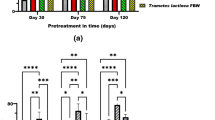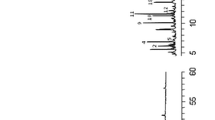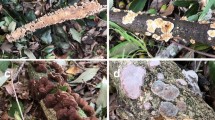Abstract
Trembling aspen wood (Populus tremuloides L.) was treated with white rot fungus Ceriporiopsis subvermispora for 1, 2, 4, and 6 weeks. As fungal decay advanced, lignin contents were decreased gradually up to ca. 27.5% (based on the Klason residues of the control) after 6 weeks. Alkali solubility of cell wall residues was increased until 4 weeks of fungal treatment, but additional treatment did not cause any effects. Milled wood lignins (MWLs) were isolated from the decayed woods by Björkman’s procedure and subjected to thioacidolysis and analytical pyrolysis to investigate the modification of lignin structures during fungal degradation. Thioacidolysis revealed that the yields of trithioethylated C6C3 monomers, as a parameter for frequency of β-O-4 linkages in lignin, were substantially reduced (-20%, based on the control) in MWLs isolated from decayed woods. Analytical pyrolysis revealed that the relative amounts of coniferyl alcohol and sinapyl alcohol in the pyrolysates were lowered dependent on the biodegradation time, whereas an elevation of C6C1 and C6C2 pyrolytic phenols was observed. The results from both analytical methods strongly suggested that β-O-4 linkages were cleaved by C. subvermispora. Specially, degradation of syringyl-type lignin seems to be preferred.
Zusammenfassung
Espenholz (Populus tremuloides L.) wurde für eine Dauer von 1, 2, 4 und 6 Wochen dem Weißfäulepilz Ceriporiopsis subvermispora ausgesetzt. Nach sechswöchigem biologischem Abbau verringerte sich der Ligningehalt der Holzproben allmählich bis auf ca. 27.5% des ursprünglichen Klason-Ligningehaltes, wohingegen die MeOH-Extraktstoffe erheblich zunahmen. Bis zu einer Inkubationszeit von vier Wochen stieg die Alkalilöslichkeit der Zellwandsubstanzen an; eine längere Abbaudauer zeigte jedoch keine weiteren Auswirkungen. Aus dem abgebauten Holz wurden nach dem Björkman-Verfahren Milled Wood Lignine (MWLs) isoliert und mittels Thioacidolyse und analytischer Pyrolyse wurde die Veränderung der Ligninstruktur durch die Pilzeinwirkung untersucht.
Die Thioacidolyse zeigte, dass sich die relativen Mengen von C6C3 Trithioethylat-Monomeren, die als Parameter für die Häufigkeit der β-O-4 Bindungen im Lignin dienen, aufgrund der enzymatischen Aktivität des Pilzes um 20% verringert hatten.
Die relativen Mengen von Coniferyl- und Sinapylalkohol in den Pyrolyseprodukten der MWLs sanken mit der Dauer des biologischen Abbaus, wohingegen gleichzeitig eine deutliche Zunahme der Phenole des Typs C6C1 und C6C2 beobachtet werden konnte.
Die Ergebnisse beider Abbaumethoden deuten darauf hin, dass C. subvermispora die β-O-4 Bindungen, insbesondere die des Syringyl-Lignins, spaltet.
Similar content being viewed by others
References
Akhtar M, Blanchette RA, Myers G, Kirk TK (1998) An overview of biomechanical pulping research. In: Young RA, Akhtar M (eds) Environmentally friendly technologies for the pulp and paper industry. Wiley Interscience, New York, pp 309--340
Björkman A (1956) Studies on finely divided wood. I. Extraction of lignin with neutral solvents. Svensk Papperstidn 59:477--485
Böttcher JH (1993) Quantitative Analyse von Holz und Holz-Komponenten mittels FTIR-Spektroskopie unter Anwendung multivariater statistischer Verfahren. PhD Thesis, University of Hamburg, Germany
Breen A, Singleton FL (1999) Fungi in lignocellulose breakdown and biopulping. Curr Opin Biotechnol 10:252--258
Choi JW, Faix O, Meier D (2001) Characterization of residua lignins from chemical pulps of spruce (Picea abies L.) and beech (Fagus sylvatica L.) by analytical pyrolysis-gas chromatography/mass spectrometry. Holzforschung 55:185--192
Daina S, Orlandi M, Bestetti G, Wiik C, Elegir G (2002) Degradation of β-5 lignin model dimers by Ceriporiopsis subvermispora. Enzy Microbiol Technol 30:499--505
Dence CW (1992) The determination of lignin. In: Dence CW, Lin SY (eds) Methods of lignin chemistry. Springer-Verlag, Heidelberg, pp 33--61
Faix O, Meier D, Fortmann I (1990a) Thermal degradation products of wood. Gaschromatographic separation and mass spectrometric characterization of monomeric lignin derived products. Holz Roh- Werkst 48:281--285
Faix O, Meier D, Fortmann I (1990b) Thermal degradation products of wood. A collection of electron-impact (EI) mass spectra of monomeric lignin derived products. Holz Roh- Werkst 48:351--354
Faix O, Bremer J, Schmidt O, Stevanovic JT (1991) Monitoring of chemical changes in white-rot degraded beech wood by pyrolysis-gas chromatography and Fourier-transform infrared spectroscopy. J Anal Appl Pyrol 21:147--162
Ferraz A, Cordova AM, Machuca A (2003) Wood biodegradation and enzyme production by Ceriporiopsis subvermispora during solid-state fermentation of Eucalyptus grandis. Enzy Microbiol Technol 32:59--65
Guerra A, Mendonca R, Ferraz A (2002) Characterization of the residual lignins in Pinus taeda biodegraded by Ceriporiopsis subvermispora by using in situ CuO oxidation and DFRC methods. Holzforschung 56:157--160
Guerra A, Mendonca R, Ferraz A (2003) Molecular weight distribution of wood components extracted from Pinus taeda biotreated by Ceriporiopsis subvermispora. Enzy Microbiol Technol 33:12--18
Guerra A, Mendonca R, Ferraz A, Lu F, Ralph J (2004) Structural characterization of lignin during Pinus teada wood treatment with Ceriporiopsis subvermispora. Appl Environ Microbiol 70:4073--4078
Hammel KE, Tien M, Kalyanaraman B, Kirk TK (1985) Mechanism of oxidative Cα-Cβ cleavage of a lignin model dimmer by ligninase. J Biol Chem 260:8348--8353
Jensen KA, Bao W, Kawai S, Srebotnik E, Hammel KE (1996) Manganese dependent cleavage of nonphenolic lignin structures by Ceriporiopsis subvermispora in the absence of lignin peroxidase. Appl Environ Microbiol 62:3679--3686
Kirk TK, Tien M, Kersten PJ, Mozuch MD, Kalyanaraman B (1986) Ligninase of Phanerochaete chrysosporium. Mechanism of its degradation of the non-phenolic arylglycerol β-aryl ether substructure of lignin. Biochem J 236:279--287
Lapierre C, Monties B, Rolando C (1986) Thioacidolysis of poplar lignins: Identification of monomeric syringyl products and characterization of guaiacyl-syringyl lignin fraction. Holzforschung 40:113--118
Lundell T, Schoemaker H, Hatakka A, Brunow G (1993) New mechanism of Cα-Cβ cleavage in non-phenolic arylglycerol β-aryl ether lignin substructures catalyzed by lignin peroxidase. Holzforschung 47:219-224
Messner K, Srebotnik E (1994) Biopulping: an overview of developments in an environmentally safe paper-making technology. FEMS Microbiol Rev 13:351--364
Mosai S, Wolfaardt JF, Prior BA, Christov LP (1999) Evaluation of selected white rot fungi for biosulfite pulping. Bioresource Technol 68:89--93
Nagarathnamma R, Bajpai P, Bajpai PK (1999) Studies on decolorization, degradation and detoxification of chlorinated lignin compounds in kraft bleaching effluents by Ceriporiopsis subvermispora. Process Biochem 34:939--948
Rajakumar S, Gaskell J, Cullen D, Lobos S, Karahanian E, Vicuna R (1996) Lip-like genes in Phanerochaete sordida and Ceriporiopsis subvermispora, white rot fungi with no detectable lignin peroxidase activity. Appl Environ Microbiol 62:2660--2663
Sarkanen KV, Hergert HL (1971) Classification and distribution. In: Sarkanen KV, Ludwig CH (eds) Lignins, Occurrence, Formation, Structure and Reactions. Wiley-Interscience, New York, pp 43--94
Srebotnik E, Jensen Jr KA, Kawai S, Hammel KE (1997) Evidence that Ceriporiopsis subvermispora degrades nonphenolic lignin structures by a one electron-oxidation mechanism. Appl Environ Microbiol 63:4435--4440
Srebotnik E, Jensen Jr KA, Hammel KE (1994) Fungal degradation of recalcitrant nonphenolic lignin structures without lignin peroxidase. Proc Nat Acad Sci USA 91:12794--12797
Souza-Cruz PB, Freer J, Siika-Aho M, Ferraz A (2004) Extraction and determination of enzymes produced by Ceriporiopsis subvermispora during biopulping of Pinus taeda wood chips. Enzy Microbiol Technol 34:228--234
Umezawa T, Higuchi T (1987) Mechanism of aromatic ring cleavage of β-O-4 lignin substructure models by lignin peroxidase. FEBS Lett 218:255--260
Author information
Authors and Affiliations
Corresponding author
Rights and permissions
About this article
Cite this article
Choi, JW., Choi, DH., Ahn, SH. et al. Characterization of trembling aspen wood (Populus tremuloides L.) degraded with the white rot fungus Ceriporiopsis subvermispora and MWLs isolated thereof . Holz Roh Werkst 64, 415–422 (2006). https://doi.org/10.1007/s00107-006-0133-9
Published:
Issue Date:
DOI: https://doi.org/10.1007/s00107-006-0133-9




